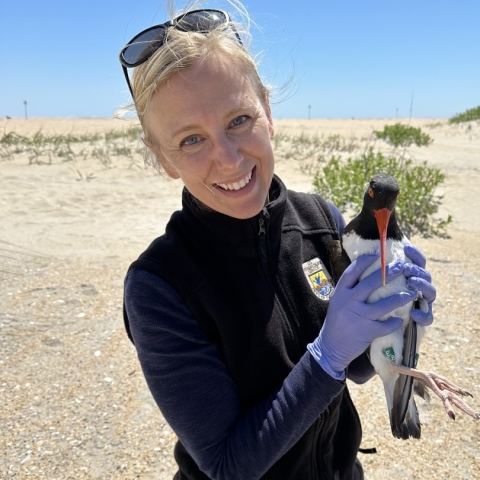
100 Conservation Way
Manteo, NC 27954
United States
About Becky Harrison
PhD (2008), MSc (2003), BSc (1999).
Dr. Harrison has spent the last 20+ years serving in multiple roles providing scientific expertise and leadership in different collaborative conservation networks. Much of her work has focused on large-scale conservation design including post-doc research evaluating monarch butterfly migration patterns around the world as they related to infectious disease dynamics. She began working for the USFWS in 2011 and initially developed projects for the South Atlantic Inventory and Monitoring Program. She also served as the Assistant Recovery Coordinator and then Project Lead for the red wolf recovery program. In her current position as a Supervisory Biologist in the Coastal North Carolina Wildlife Refuge Complex, she coordinates biological monitoring efforts across a diverse geography, addresses complex resource management issues, and provides science support for numerous monitoring projects with partners across universities, state agencies, and non-profit organizations to develop innovative, effective conservation practices. She also serves as the Recovery Lead for the endangered St. Francis’ satyr, a species she’s worked with since graduate school with important partners at the Department of Defense, Fort Bragg Army Installation, Michigan State University, and North Carolina State University.
Publications from past 15 years:
Velasquez-Montoya, L., E. Sciaudone, R. B. Harrison, M. F. Overton. 2021. Habitat mapping on a barrier island: yearly changes, storm effects, and recovery periods. Applied Geography 35: 102557.
Majewska, A.A., D.A. Satterfield, R.B. Harrison, S. Altizer, and J. Hepinstall-Cymerman. 2019. Urbanization predicts infection risk by a protozoan parasite in non-migratory populations of monarch butterflies from the southern coastal U.S. and Hawaii. Landscape Ecology 34: 649-661.
Simonis, J.L., R.B. Harrison, S.T. Long, D.R. Rabon, Jr., W.T. Waddell, and L.F. Faust. 2018. Managed movement increases metapopulation viability of the endangered red wolf. Journal of Wildlife Management 82: 573-582.
Brzeski, K., R. Harrison, D. Rabon Jr., K. Wolf, W. Waddell, and S. Taylor. 2015. Infectious disease and red wolf conservation: assessment of disease occurrence and associated risks. Journal of Mammalogy 96: 751-761.
Pierce, A. A., J. C. de Roode, S. Altizer, andR. A. Bartel. 2014. Extreme heterogeneity in parasitism despite low population genetic structure structure
Something temporarily or permanently constructed, built, or placed; and constructed of natural or manufactured parts including, but not limited to, a building, shed, cabin, porch, bridge, walkway, stair steps, sign, landing, platform, dock, rack, fence, telecommunication device, antennae, fish cleaning table, satellite dish/mount, or well head.
Learn more about structure among monarch butterflies inhabiting the Hawaiian Islands. PLOS One: 10.1371/journal.pone.0100061.
Bartel, R. A., and D. R. Rabon, Jr. 2013. Re-introduction and recovery of the red wolf in the southeastern USA. Pages 107-115 in P. S. Soorae (ed.), Global re‐introduction perspectives: additional case studies from around the globe. IUCN/SSC Re‐introduction Specialist Group, Abu Dhabi, UAE.
Hall, R. J., S. Altizer, and R. A. Bartel. 2013. Greater migratory propensity in hosts lowers pathogen transmission and impacts. Journal of Animal Ecology 83: 1068-1077.
Bartel, R. A., and S. Altizer. 2012. From protozoan infection in monarch butterflies to colony collapse disorder in bees: are emerging infectious diseases proliferating in the insect world? Pages 284-301 in New directions in conservation medicine: applied cases of ecological health (A. A. Aguirre, P. Daszak, and R. S. Ostfeld, editors), Oxford University Press, London. (Invited book chapter).
Bartel, R. A., K. S. Oberhauser, J. De Roode, and S. Altizer. 2011. Monarch butterfly migration and parasite transmission in eastern North America. Ecology 92 (2): 342‐35 (cover feature).
Altizer, S.,R. Bartel, and B. Han. 2011. Animal migration and infectious disease risk. Science 331: 296-302.
Bartel, R. A., N.M. Haddad, and J. P. Wright. 2010. Ecosystem engineers maintain a rare species of butterfly and increase plant diversity. Oikos 119: 883-890.
Davis, A., S. Altizer, K. Oberhauser, L. Ries, D. Frey, T. Crewe, E. Howard, E. Rendon-Salinas, R. Bartel, R. Batalden and N. Nibbelink. 2009. Recommendations for integrating monarch butterfly monitoring data in North America to address conservation and management needs. Report to the Commission for Environmental Cooperation.
Bartel, R. A., and J.O. Sexton. 2009. Using a time series of satellite imagery to detect potential habitat for an endangered species. Ecography 32: 888‐896.
Bartel, R. A., F. F. Knowlton, and L. C. Stoddart. 2008. Mammal abundance trends from two Great Basin sites. Journal of Mammalogy 89: 1170‐1183.
Kuefler, D., N. Haddad, S. Hall, B. Hudgens, R. Bartel, and E. Hoffman. 2008. Population structure and habitat use for the endangered St. Francis Satyr butterfly, Neonympha mitchellii francisci. American Midland Naturalist 159: 289-320.
Hess, G. R., R. A. Bartel, A. K. Leidner, K. R. Rosenfeld, M. J. Rubino, S. B. Snider, and T. H. Ricketts. 2006. Scale matters: using indicator taxa at varying grains and extents. Biological Conservation 132: 448-457.